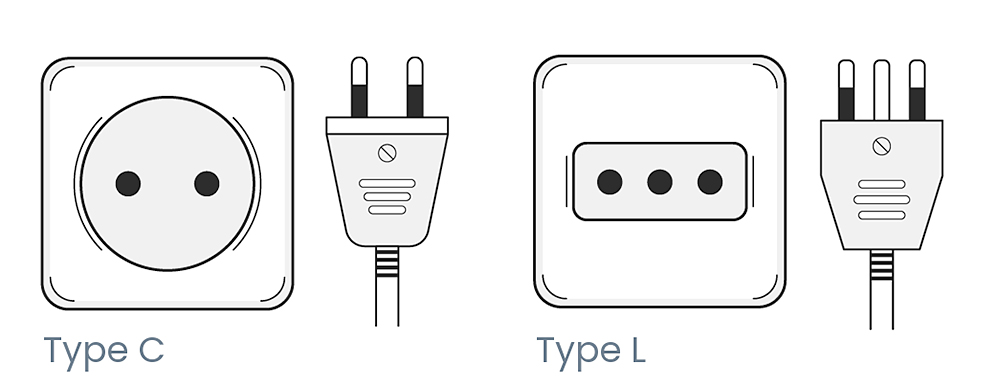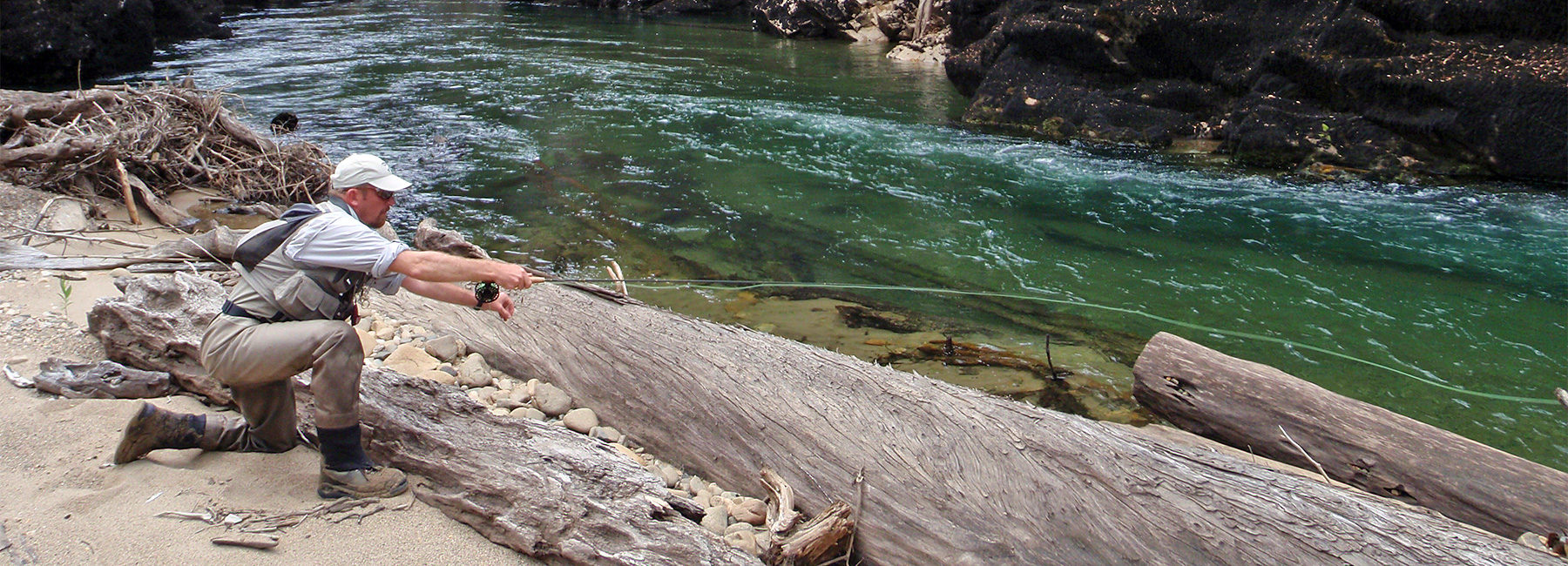GPS Coordinates: 44°42’55.86″S 72°4’46.77″W
Trip Questionnaire: Please click on the link below. This will take you an electronic questionnaire form that we ask you to complete and submit to The Fly Shop®. Please be sure to click the “Submit” button at the end of the form. The information provided will help us — and the outfitter best coordinate your trip.
THANK YOU!! CLICK HERE
This tackle and equipment planner is a guideline to help anglers assemble a reasonable collection of flies and necessary equipment. You are by no means required to purchase all of this equipment, but do make sure you have a good cross-section. It is generally true that properly outfitted and prepared anglers have the best chance of having a trip of a lifetime.
Although selling fly fishing tackle and flies is part of what The Fly Shop® does, it is not our main concern. Our biggest priority is that people have a great trip. That being said, we feel there is no-one better suited to outfit you for your trip. It is a trip we’ve taken dozens of times. We know what works, but more importantly, we know what works best. We’d love to have your business if you need to purchase new equipment.
One thing we’ve all learned from years of fishing in Patagonia, and the word that we as anglers must always keep in the back of our minds, is “ADAPT.” It is almost impossible to tell what kind of lines and flies are going to be most successful on the river at a given time. Conditions can change without warning and we must be able to adapt to the conditions at hand. Thus, you’ll want to bring a wide selection of fly tackle and enough different types of flies to meet conditions.
Guides will normally have a fly on hand in case you don’t have the right one in your box for the situation, but we cannot guarantee this, as equipment is not included in your trip, nor is it available for purchase at the lodge. Therefore, you’ll want to come prepared with everything you’ll need.
If you have any questions concerning tackle and equipment recommendations, please feel free to call us, toll-free, at (800) 669-3474.
Contact Numbers
The Fly Shop®
4140 Churn Creek Road
Redding, CA 96002
(800) 669-3474 | (530) 222-3555 | travel@theflyshop.com
La Posada de los Farios
Coyhaique Office: 011-56-67-223-6402
Cell: 011-56-9-829-09371 | E-mail: info@chilepatagonia.com
South America Travel Agent
Holdy Tours
Alicia Regueiro
(800) 446-1111 | (925) 927-6617 | Alicia@holdytours.com
- Can book your air and any additional hotel rooms you may request.
Embassy of the USA in Chile
Avenue Andrés Bello 2800, Las Condes Santiago, Chile
PH: (56-2) 330-3000 | FAX: (56-2) 330-3710, 330-3160 | https://cl.usembassy.gov/
- Embassy hours: 8:30 a.m. – 5 p.m.
For U.S. citizens solely inquiring about passport, citizenship and other consular services not related to visa matters, please E-mail at SantiagoAmCit@state.gov
Restaurant Recommendation from Rex
“There is a restaurant in Santiago called La Casa Vieja and it is located on Av. Manuel Montt 1631 /Providencia (a sector of Santiago). This is a no-frills place that has great service and serves traditional Chilean dishes. It is a local’s favorite, and reasonably priced. I suggest asking for the Machas (razor clams) Parmesana for an appetizer as soon as you arrive (they sometimes run out). The Ostiones (scallops) are good too. Otherwise, almost any main dish you order is good. Some traditional dishes are Pastel de Choclo (corn casserole), Caldillo de Congrio (fish soup), Plateada (beef roast), Filete ala Pimienta (pepper steak). I like the Papas Duquesas (Duchess Potatoes) to go along with beef. Ensalada Chilena (tomato and onion salad) is always good too.”
Recommended Equipment
Fly Rods:
Multi-piece, 5 or 6 weight fly rods will cover most of the fishing situations you’ll encounter in Chile. A 7-weight rod is an important rod choice for some of the bigger water and if you fish the coastal rivers. We strongly recommend a multi-piece travel rod (3, 4 or 5 piece). Top-quality rods you might consider are: Winston, Sage, or Scott. For great value options, consider The Fly Shop’s Signature H2O series.
Fly Reels:
Good quality, lightweight fly reels, with simple disk drags, are the best choice. Reels should be filled with fresh 20-pound backing. Reel models to consider include: Ross, The Fly Shop’s L2A, Galvan, Abel, Hatch, and Hardy reels. Extra spools are a definite advantage. 75 – 125 yards of backing is more than adequate.
Fly Lines:
You will basically need two fly lines at La Posada: a weight-forward floater, and a 15′ sink tip fly line – Type IV – VI sink rate.
Leaders & Tippet:
For a week’s fishing, you will need no less than five tapered leaders – 9 ft. (3X) for your floating line and two (4 – 6 ft.) (0X) leaders for your sinking fly lines. For tippet, bring fresh spools of (4X), (3X) and (2X). Rio makes some of the best mono tippet and leader material available.
Fishing Vest/Tackle Pack:
For vests we like a high quality product, in a shorty model. Choose one that has room for a rain jacket or camera in the back. Simms vests are great choices. If you prefer a tackle pack, take a good look at the Fishpond and Patagonia products.
Boat Bags:
These hold extra gear, clothes, flies, camera, snacks, etc., and keep them safe and dry during floats and boat rides. We recommend Patagonia and Fishpond boat bags.
Tools:
Nippers, flat jawed hemostats, a hook file, floatant. These are essential on any fishing trip.
Wading Staff:
If you use a staff at home, bring it along. They can be handy, particularly the collapsible models. While Patagonian rivers are considered easy to moderate wading, there will always be a fish that likes to hang out in swifter deeper water, tempting you into position.
Polarized Sunglasses:
Good quality polarized sunglasses are a must both for seeing fish and for safety. Brown, amber and copper are the best lens colors. Costa and Smith make excellent fly fishing sunglasses, and even offer prescription options. Bring a spare pair!
Camera & Case:
Waterproof or splash-proof Digital cameras are handy. Canon or Nikon digital SLR cameras with a good zoom lens (28 – 80) are the best. Almost all camera battery chargers these days can accommodate a 100 – 240 volt range.
The best hard plastic cases to protect expensive camera equipment are made by Pelican Products, www.pelican.com
Headlamp:
Headlamps are great for late night gear fiddling and trips to the loo. We prefer a model with LED bulbs and that can be recharged.
Sun Protection:
The summer weather in Chile Patagonia is generally pleasant. Average temperatures range between the low 50’s and mid 80’s. Though usually not hot, the ultra-violet rays of the sun in this part of the world are very intense and will burn even the most sun-seasoned anglers. Wide-brimmed hats, long-sleeved shirts, and frequent use of a strong sun block (SPF 30 UVA/UVB+) are highly recommended. Sun gloves will save the backs of your hands.
Flies for La Posada de los Farios
When you walk the banks and meadows of this region of Patagonia, you’ll often raise a literal cloud of hoppers. The fish are keyed to the hoppers or anything that floats and looks buggy. But opportunities for classic streamer fishing abound too. Each angler should have about 2 dozen terrestrial patterns, a half dozen assorted streamers, some assorted dry flies, and maybe a couple each of dragonfly and mouse patterns. 48 flies should be just about right for the week. Guides normally have a very limited selection on hand in case you don’t have the right fly for the situation. But flies are NOT available for sale at the lodges.
We also offer an easy way to know you have the correct flies for your trip. We offer a Chile Trout Selection that can be customized for your specific dates during your visit to La Posada de los Farios. This selection comes with a great assortment of the below flies loaded into the perfect fly box.
Attractors & Terrestrials: These patterns are very important and a must!
- Rance’s Gypsy King – #4 (A MUST!)
- Hopper Grande – #8 – 12; tan
- Chubby Chernobyl – #6 – 8; black (A MUST!)
- Small beetle – #10 – 12
- Turk’s Tarantula – #8
- Dave’s Foam Hoppers – #6 – 10
- Double Dutch Bug – #10
- Fat Albert – A MUST!
- Clark’s Cicada – #10
Traditional Dries: Not as critical as above patterns, but good to have a selection.
- Parachute Adams – #16
- Cutter’s E/C Caddis – #14 – 16
- Stimulators – #10 – 14
- Parachute Ants – #16 – 18; black
- Compara Duns, Quigley’s Cripple – #16
- Mercer’s Missing Link – #14 – 16
Streamers/Large Nymphs: Not as critical as the attractors and terrestrials but important to have with you.
- Dragon Fly Nymphs – #6; olive
- Kaufman’s Stonefly Nymphs – Large; olive
- GB Chilean Rubber Buggers – #4
- GTC Autumn Splendor – #4
- Beldar’s Rubberlegs – #4; olive, black, brown
- CH Fire Tiger Bugger
Nymph Selections: Nymphs haven’t been consistently important in past years, but it might be advisable to bring along a short selection of small size 10, 12, 14 standard nymphs.
- Bitch Creek nymphs and other buggy rubber-legged nymphs – #4 – 8
- Bead Heads – Prince, Hare’s Ear, Birds Nests, Copper Johns, Pheasant Tails
Early Season Flies: (November & December)
Dries:
- Chernobyl Ants – #6 – 8; black
- Rance’s Gypsy Kings – #2 – 8
- Turk’s Tarantulas – #6 – 8; various colors
- Foam beetles and ants – small to large sizes
- Caddis & Stimulators – #8 – 16
- Mayfly BWO Dun and emerger patterns – #14 – 16 (a few)
Streamers:
- Wooly Buggers w/ white rubberlegs – #4 – 8; black, olive, brown (with or without cone or beadhead)
- Beadhead Crystal Buggers – #4 – 8; black, olive, silver
- Conehead Zuddlers – #4 – 6; olive/olive, black/silver
- Beldar’s Rubberlegs – #4
- Double Bunny String Leech
Nymphs:
- Beadheads: prince, pheasant tails, hare’s ear, lightning bug, copper john – #12 – 16
- Beaded Soft Hackles – #12 – 16
- Dragon & Damselfly Nymphs – #6 – 12
- Bitch Creek – #6 – 8 (weighted or beadhead/conehead)
- PT Prince – #12 – 14
- Rubberleg Stones – #6 – 8 (a few)
Mid-Season Flies: (Mid-January to Mid-March)
In addition to the streamer selection above, large foam terrestrials that imitate the Cantaria, or giant stag beetles are the main flies used during the heart of the season: Gypsy Kings, Monster Beetles, Black Bottom Chernobles, Fat Albert, etc
- Hoppers: Smaller sizes in Jan and early February (#8, #10), growing bigger as the season progresses (#6-#8.): Dave’s Hopper, Parachute, Foam Tan, Burk’ Spent, Basin, Streambank, Parachute Madame-X #8
- Flying Ant Hatches are possible starting about mid-February. Good to have some foam or parachute ants’ size #16 black on hand just in case.
Late Season Flies: (Mid-March through April)
- May Flies: (As the weather cools starting about mid-March the may fly action cranks up). #14-#18. Parachute Adams, March Browns, PMDs, Callibaetis, Comparaduns – olive, etc.
- Emergers: #14-#18. Spotlight Emerger – brown, Trina’s Budding, Brooks, Sprout Fly, etc.
- Nymphs: Pheasant Tails, Princes, Copper Johns
- Streamers: Crystal Buggers – black, olive, silver #6-#12 (smaller sizes for windy days when fish are not on the mays)
Coastal Flies: (good all season)
- Woolly Buggers – #2 – 8; weighted, white, black, gray, olive, purple
- Crystal Rubber Bugger – olive, purple, black
- Rabbit Fur Leeches – #2 – 8; purple, black, olive, white, tan, egg sucking, etc.
- Articulated Leeches – in darker colors primarily
- Home Invader – olive/white
- Chilean Rubber Bugger
- Milt’s Belly Pond Smelt
- Double Bunny
- Clouser’s: – olive/white, black, yellow
- Mercer’s Poxyegg Leech
Recommended Clothing
The weather in Patagonia is constantly changing. One afternoon it may be 70°+ and sunny, downright hot; then only a few hours later it may be rainy, damp, windy and in the low 50°s or cooler. It is not uncommon to have morning temperatures in the mid to low thirties, especially when clear weather prevails, warming to a balmy 50° or 60° degrees by the end of the day. Clothing strategies should be based on the “layering system.” By using the “layering system,” anglers can adapt to whatever Mother Nature dishes out. The whole idea behind layering is to trap heated air (generated by your body and stored between the different layers of insulation), thus keeping you warm.
Here is the formula preferred by the staff at The Fly Shop®:
Base Layer:
Start off with a synthetic fabric next to your skin. This often is a pair of thermal underwear (tops and bottoms) and they usually come in three weights: light, mid and expedition or heavy. According to your individual metabolism, pick what is best for you. Synthetic (non-cotton) materials retain little moisture and “wick” moisture away from your skin. This is very important when you are walking in waders or when outside temperatures heat up. 1 set of midweight Simms or Patagonia (tops and bottoms).
Thermal Layer:
Your second layer of insulation should match the weather and conditions you are going to be fishing in. Lightweight insulation for cool weather, mid-weight for colder conditions and heavy weight for really frigid days. Fleece is an outstanding choice here in either tops and bottoms or overalls. Merino Wool is also a good choice as it stays warm when damp, though dries very slowly. 1 set fleece pants – Simms or Patagonia. 1 Fleece jacket – Simms or Patagonia.
Waterproof Shell:
The final layer on your upper body should be a rain jacket. High quality Gore-Tex type products are the best. Your rain jacket should be 100% waterproof and breathable, multi-layered, with sealed seams. Buy the best rain jacket you can afford, as it is one of the most important pieces of equipment you can own. The Simms, Skwala, and Patagonia are high quality jackets designed specifically for fly fishermen.
Waders:
Stocking foot, breathable chest waders are the only way to go. You will experience little or no moisture build-up inside the waders, even after a long hike; they wear like iron, pack down very well, and are comfortable to be in all day. For safety we strongly recommend wearing a wading belt at all times. The Simms, Skwala and Patagonia makes a product that is equally durable and comfortable.
Socks:
For a week’s fishing trip, three pairs of heavy socks will be adequate. Wool, polypro or a combination of both are the best choices in sock material. Try on your socks with your waders and wading boots before you go to insure you have plenty of room to move your toes. Being unable to move your toes and cramping your feet in your wading boots are the biggest reasons for numb toes and cold feet. Simms and Patagonia synthetic and Smartwool are the way to go.
Wading Boots:
Wading at La Posada is very easy, and rubber soled boots are highly recommended to prevent spreading invasive species. Patagonia, Simms and Korkers – there are lots of good brands. Metal studs are fine to put into the shoe soles, though are seldom needed.
Hats:
Bring a hat with a good brim for sun protection, and a warmer stocking hat for cold days (which can occur anytime during the season.)
Gloves:
Fingerless insulating gloves are great for boat rides and cold days. We have had the best success with synthetic or wool gloves, rather than neoprene which retain water. Simms fleece fingerless gloves are great, or TFS fingerless fleece gloves are an economic way to go. Sungloves are a great idea, to protect your hands from the intense Patagonia sun.
General Lodge Information
Electricity:
Electricity in Chile is 220 volts Most modern day chargers are designed to function with 120 – 220 volts. You will need a universal plug adapter, one that will function with one of the outlets below.

Non-Anglers:
Non-angling guests should be prepared for a variety of outdoor activities. Hiking, horseback riding, visits to neighboring substance farms, local artisans, carriage rides, birding and photography are some of the activities available. Non-angling guests should bring good raingear (jacket and pants) hiking boots, a warm fleece, camera, binoculars, daypack, and a good sun hat.
Chilean Fishing License:
Your Chilean fishing license is not included in your La Posada de los Farios angling package. Cost of the license is $75USD per person. Please be prepared to pay the lodge this fee upon arrival.
In order to have your fishing license pre-purchased and waiting for you, we need the following information. Part of your lodge questionnaire that will be sent to you:
-
- Full name as it reads on your passport
- Passport number
- Date of birth
- Mailing address
Gratuities:
Gratuities are a personal decision based on service rendered. Normally guides and staff are tipped upon departure in accordance to their individual effort and service. In most cases we like to leave a gratuity with Rex. A good rule of thumb for figuring an amount to leave is 10-15 percent of the package cost.

